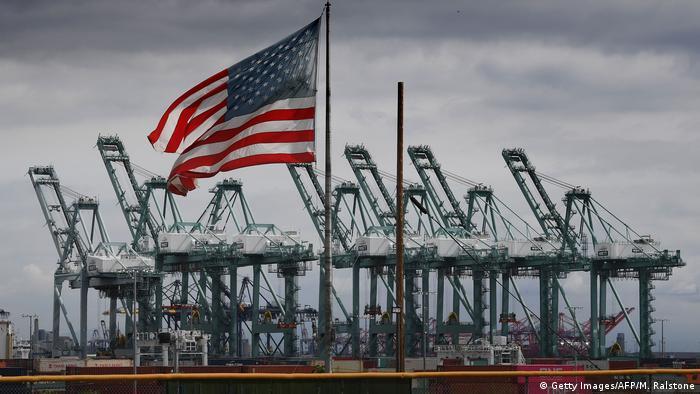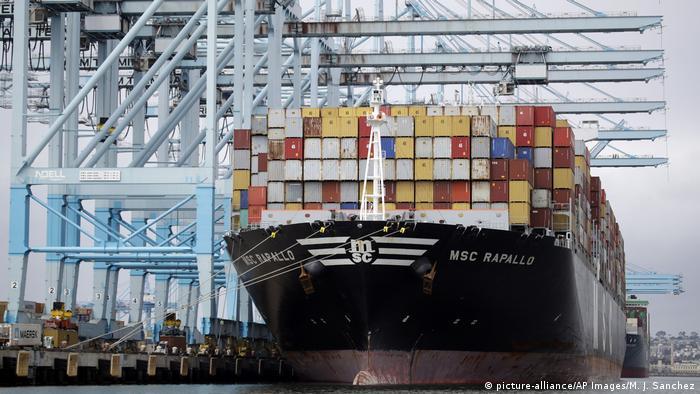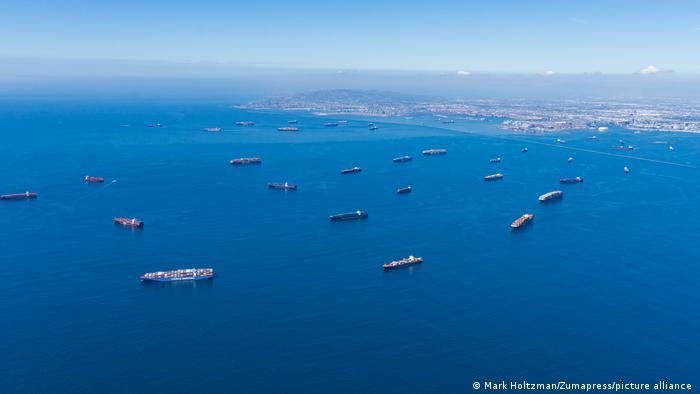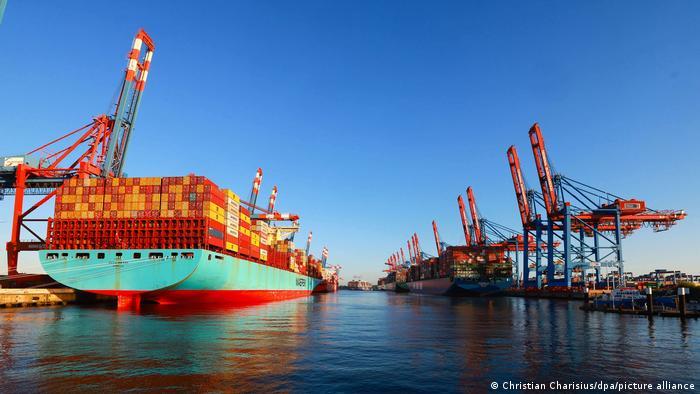US Labour Dispute: Dock Workers Say 'No' to Port Automation

The 29 West Coast ports under negotiation handle nearly 40% of the United States' imports
The labour contract of 22,000 West Coast dock workers expired on July 1 and negotiations for a new one are reportedly stalled. A key issue for the workers and the employers is one that has rattled the ports for six decades: automation.
Terminal operators and ocean carriers claim that automated technology at the ports is necessary to keep the US competitive. Yet the dock workers union argues that while automated ports are killing jobs and stripping worker power, they are not even leading to an increase in productivity.
"I like the work, but the sad part is there have been a large number of jobs that have been eliminated because of it," Rebecca Schlarb, an automation coordinator at the Long Beach Container Terminal, one of two automated ports on the US West Coast, told DW.

The West Coast container ports of Los Angeles and Long Beach are fully automated but little efficient, a study shows
Stalled negotiations
The labour agreement under negotiation covers workers across 29 ports in California, Oregon and Washington state. That includes two of the country's most trafficked ports at Long Beach and Los Angeles.
The Wall Street Journal reported that labor talks, which began on May 10 in San Francisco, are presently stalled over a jurisdictional conflict at the Port of Seattle between the negotiating union, the International Longshore and Warehouse Union (ILWU), and a separate machinists union.
As they often are, these negotiations are incredibly high stakes. US President Joe Biden has met with both negotiating parties to encourage smooth talks, so as to prevent the monthslong shipping delays that resulted from previous disagreements between the union and employers in 2002 and 2014.
US ports are already strained due to supply chain disruptions, operating at peak capacity and handling record volumes over the past two years of the pandemic. The ports at Los Angeles and Long Beach have been rated among the world's least efficient in the World Bank and S&P Global Market Intelligence's 2021 Container Port Performance Index.
The union and the 70 terminal operators and ocean carriers represented in the negotiations by the Pacific Maritime Association (PMA) have agreed to a media blackout during the labor talks, but they released a joint statement in July announcing they have a tentative agreement on health benefits.
Stalled talks mean the ILWU and PMA have yet to settle on wages and the key issue of automation.

During the COVID-19 pandemic supply chain issues have given a rise to a sea of congestion at several West Coast ports.
A decades-old conflict
Whether more remotely operated cranes, autonomous vehicles and other automated technology should be brought to West Coast ports sits at the center of the current labour dispute.
Two automated ports reside on the US West Coast in the San Pedro Bay Complex: the Trans-Pacific Container Service Corporation (TraPac) at the Port of Los Angeles and the Long Beach Container Terminal (LBCT) at the Port of Long Beach.
Even though automation requires massive upfront investments, the PMA argues the changes are critical for American ports to increase their waning efficiency. PMA President Jim McKenna told Bloomberg news agency that this was "the key to long-term survival, long-term competitiveness."
The ILWU, on the other hand, has been arguing for years that automated technologies are job killers for their members. Employers' introduction of machines has stripped workers of their power over the docks and weakened the union.
Indeed, the issue has been front and center during labour talks for over six decades. The massive cranes, cargo ships, and rectangular containers that speckle coasts around the world were an innovation, or automation, of the mid-20th century.
Prior to the 1960s, during the "break-bulk" era of shipping, longshoremen loaded and unloaded cargo ships in cases, nets, or on wooden pallets. It was meticulous, dangerous and time-consuming work that required large numbers of dock workers.

In the 1960s, a process called containerization began and changed infrastructure on ships and ports
The ILWU and PMA struck a deal in 1960 to allow the burgeoning technologies on the ports, but neither party expected just how much the automation would transform work on the waterfront. Tens of thousands of longshoremen jobs were shed from the ports as employers decided to cut labour costs.
In 1971, a few years after so-called containerization really took hold on the ports, West Coast dock workers were fed up with the deterioration of their jobs and led the union's longest strike in history — 134 days. It was the first such coordinated strike for the union, shutting down ports up and down the coast.
While workers won wage increases, automation remained on the table, and in the decades following, the ILWU has conceded to more and more automated technology at the ports. Most recently in 2008, the union explicitly accepted machine-automation technology in their labour agreement.
More robots, less productivity
Employers are insistent that automation will not kill jobs. The PMA commissioned a report showing that the West Coast's two automated port terminals, TraPac and LBCT, actually saw a 31.5% increase in paid hours for dock workers, in addition to container processing twice the speed as nonautomated ports.
But workers and labour researchers dispute both findings. Patrick Burns, a senior researcher at the Los Angeles-based nonprofit Economics Roundtable told DW that the influx of shipping volume over the past two years masked the job loss at both terminals.
Accounting for the job hours per container that went through the ports, Burns and his colleague Daniel Flaming found in their report "Someone Else's Ocean" — which was underwritten by the ILWU — that automation reduced employment by 37% to 52% at LBCT, and by 34% to 37% at TraPac.
Nearly 580 jobs were eliminated at the ports in 2020 and 2021, "a huge, kind of staggering amount of job loss," according to Burns.
Schlarb has been a dock worker since 1991 and was the first woman to be elected business agent at ILWU Local 63. She describes her work as a "bittersweet job," because while she likes the position, it's clear to her that automation technology has cut many jobs from the port.
According to her, if LBCT were a conventional port, it'd have 138 crane operators and 69 signal people. But with automated technology, "the signal people were eliminated and now crane operators are down to 14 in a remote location."
Burns and Schlarb explained that job losses have a negative effect on the surrounding communities.
"They're the types of jobs where you can get health coverage, buy a house and maybe put your child through college," said Burns adding that "those types of jobs are extremely valuable for the region."
Schlarb said dock workers would pump their high wages into the local economy and if they would their jobs "that money is gonna start to dry up."
Ironically, Burns' research also found that automated ports were 7% to 15% less productive than nonautomated ports.
Schlarb's own experience backs up the findings. If cranes suffer mechanical failures, she said, or the autonomous ground vehicles lose their wireless network connection, for example, repairs are less seamless and disruptions are more severe than at nonautomated ports.
"Cranes go down quite often, and if one crane goes down, for a mechanic to safely enter, both cranes [in the specific bay] and other adjacent cranes have to be shut down too," Schlarb explained. "Now you've got thousands of containers within the two blocks while the repairs are being done. In a conventional operation, you would lose that bay where the crane broke down and that would have been only 30 containers."
Schlarb believes workers across the economy should be concerned about automation. Even as an automation coordinator, Schlarb doesn't believe automation is always the answer. "Just because you can advance something doesn't mean you need to," she said.
Some things work better the old-fashioned way.
"There is nothing more beautiful to watch than a group of longshoremen executing a plan," she added.
Edited by: Uwe Hessler
Get the latest reports & analysis with people's perspective on Protests, movements & deep analytical videos, discussions of the current affairs in your Telegram app. Subscribe to NewsClick's Telegram channel & get Real-Time updates on stories, as they get published on our website.
























